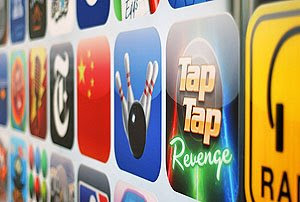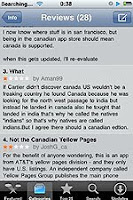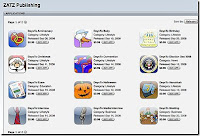 You’ll get a numb feeling, usually after an equilibrium state is reached, the warm feeling that once filled inside you, is getting slowly cold when all that you’ve expected finally taken shape and revealed before you.
You’ll get a numb feeling, usually after an equilibrium state is reached, the warm feeling that once filled inside you, is getting slowly cold when all that you’ve expected finally taken shape and revealed before you.When Apple’s CEO, Steve Jobs announced the centralized-sales of apps for iPhone and iPod Touch at the App Store; we’re pretty much excited to know what it’s going to be. And so, App Store is said have served up more than 100 million apps just in 60 days after the opening. An amazing numbers to be reckoned with.
But that’s exactly what have been making the visitors and consumers of App Store to reach a numb feeling, which I stated at the beginning there. The once excited place to visit, now has become avoided because of the abundant apps within. Take for instance Karen Gee, a tech-savvy 40-something Connecticut resident, says "I tend to find new apps via iPhone blogs and recommendations from friends.”
That is indeed a strange comment from Apple’s main targeted customers, the young audience & college students. Because as we all know it, App Store is the only place for iPhone/iPod Touch users to legally downlad 3rd party softwares. So what gives?
Apparently, the App Store is filled with so many apps; whether they have good and useful purpose or not. And to make things worse, there are broad categories of apps which are tough to sort trough. For example, if you open up “Entertainment” or “Games” category in App Store, there’ll be hundreds of products shown. Few of them are new, but most of them probably old ones.
 Of course, there’s product reviews underneath the apps description. But even though Apple has revoked the reviewer policy, which needed the reviewer to have purchase the app in order to give a testimonial, App Store consumers are still reluctant to purchase an app only based on reviewer’s testimonials. Most of them, rely on old-fashioned word from mouth to mouth; or look the apps up at 3rd party site reviewer such as App Shopper. Or maybe reliable weblog sites like PalmAddict. ;-D
Of course, there’s product reviews underneath the apps description. But even though Apple has revoked the reviewer policy, which needed the reviewer to have purchase the app in order to give a testimonial, App Store consumers are still reluctant to purchase an app only based on reviewer’s testimonials. Most of them, rely on old-fashioned word from mouth to mouth; or look the apps up at 3rd party site reviewer such as App Shopper. Or maybe reliable weblog sites like PalmAddict. ;-DBut one of the worst act of conduct from software developers that’s most feared by consumers, is the apps’ naming game. The apps are often offering the same or similar function, but labeled with different names. If you’ve read my post about ‘5 landscape keyboard apps for iPhone/iPod Touch email’, then you know what I’m talking about here. “There are a lot of apps that do exactly the same thing,” complains Katy Arnn, a 24-year-old student at Claremont Graduate University; “And most of them seem unnecessary.”
 One better example of these crap apps has been pointed out by Brandon at Just Another iPhone Blog; “They have one decent countdown application. One. They then took what was a good idea (the countdown program) and slapped 19 new icons on it and sent it to Apple 19 more times. All these applications do the same dammed thing (I’m sure if Apple checked the code they would see its almost line for line identical in the function/method), they take an input (some date in the future) then count down to that date. THAT’S IT!" –click on the thumbnail pic to view it larger--
One better example of these crap apps has been pointed out by Brandon at Just Another iPhone Blog; “They have one decent countdown application. One. They then took what was a good idea (the countdown program) and slapped 19 new icons on it and sent it to Apple 19 more times. All these applications do the same dammed thing (I’m sure if Apple checked the code they would see its almost line for line identical in the function/method), they take an input (some date in the future) then count down to that date. THAT’S IT!" –click on the thumbnail pic to view it larger--The irony is saddening us all, while Apple is proactively kicking out useful apps such as Podcaster and NetShare; Apple has lost focus on banning crap apps in App Store like Brandon has mentioned above.
Unfortunately, that’s not all which have made App Store to be avoided by its own ‘legally’ customers; iPhone/iPod Touch users who haven’t jailbroken their devices. According to Ben Boychuk from Macworld, it was Apple’s decision to shoehorn the App store inside of iTunes, using many of the same features that were designed to be used for music, not software.
 Rob Frankel, a Los Angeles-based branding guru said “They (Apple) did such a great job of building the entire iTunes empire. They thought they could just clone the structure. It doesn’t work.” Frankel added “Music is music and apps are apps.” What works for selling the former, he explains, may not work selling the latter. The problem, Frankel argues, is that the App Store isn’t doing what the iTunes Music Store did—making the experience of art and technology seamless.
Rob Frankel, a Los Angeles-based branding guru said “They (Apple) did such a great job of building the entire iTunes empire. They thought they could just clone the structure. It doesn’t work.” Frankel added “Music is music and apps are apps.” What works for selling the former, he explains, may not work selling the latter. The problem, Frankel argues, is that the App Store isn’t doing what the iTunes Music Store did—making the experience of art and technology seamless.The iTunes’ savvy trait to give a preview of song you’re about to purchase, also lack from App Store. Making users to buy an app out of the blue, or like the saying goes: “it’s like buying a cat in a bag full of mice” …both first idea to choose and the outcome are all bad. Users are more likely to purchase a crap app, instead of the one he/she thinks useful. Some developers already offer free or “lite” versions of their apps to entice would-be customers to buy the full version of their software. But that’s a business decision by the developers, not App Store policy.
 Still in the iTunes circle, another confusing thing that keep on drawing complaints from App Store users is the pricing policy. iTunes has more straightforward prices: Songs are $1, most albums are $10, TV shows are $2. Not so with the App Store, where apps prices vary based on developers decision; not Apple. One that kept ringing the bell is the controversial “I’m Rich” app, if you still remember it well. ~LOL~
Still in the iTunes circle, another confusing thing that keep on drawing complaints from App Store users is the pricing policy. iTunes has more straightforward prices: Songs are $1, most albums are $10, TV shows are $2. Not so with the App Store, where apps prices vary based on developers decision; not Apple. One that kept ringing the bell is the controversial “I’m Rich” app, if you still remember it well. ~LOL~
So in the end, it’s all up to Apple. Whether to keep on using current policy on its growing App Store, or implement a new more flexible policy that will benefit for all: Apple itself, software developers and App Store users.
But in the mean time, please be careful my good readers of the crap apps attack at App Store. ;-p
[blogged with my Treo 750v]

No comments:
Post a Comment